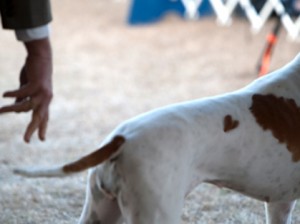From The CC Vault: What Are They Looking For?
Have you recently heard this question ringside at a dog show? Perhaps even you have asked this a hundred times over. More often than not, it is posed rhetorically as a reflection or criticism of your observation.
I am referencing the deliberations and decisions made by the AKC dog show judge. We all at one time or another have stood ringside and observed judges leaving us to shake our heads while muttering, “I must have missed something!” Even more frustrating is attending our breed specialties and we are altogether befuddled. Subsequently, this leaves us to inquire of our friends, “What are they looking for?” The judges explanation is not forthcoming unless you attend a dinner where the judge says a few words about their selections, or you may read it later in the club’s publication.
We can easily solve this issue while improving upon the adjudication process. In recent times there has been debates about adopting a few practices of the FEDERATION CYNOLOGIQUE INTERNATIONALE (FCI). For instance, we now offer a Reserve Best in Show and although I do not see our classes being restructured, I believe we can and should adopt one other highly useful and logical practice. In my opinion, we need to embrace and welcome customary judge’s critiques and grading on every entry. This is a valuable tool for exhibitors, judges, and AKC Representatives as well. The latter I will explain further on. For those who are unfamiliar with FCI Regulations for Show Judges, “The candidate has to produce a consequent critique with the good and less good points of the outline and movement of the dogs and he must pay attention to the health and welfare of the dog.”
From there the FCI qualifications given by the judges must correspond to the following definitions:
EXCELLENT may only be awarded to a dog which comes very close to the ideal standard of the breed, which is presented in excellent condition, displays a harmonious, well-balanced temperament, is of high class and has excellent posture. Its superior characteristics in respect of its breed permit that minor imperfections can be ignored; it must however have the typical features of its sex.
VERY GOOD may only be awarded to a dog that possesses the typical features of its breed, which has well-balanced proportions and is in correct condition. A few minor faults may be tolerated. This award can only be granted to a dog that shows class.
GOOD is to be awarded to a dog that possesses the main features of its breed. The good points should outweigh the faults so that the dog can be considered a good representative of its breed.
SUFFICIENT should be awarded to a dog which corresponds adequately to its breed, without possessing the generally accepted characteristics or whose physical condition leaves a lot to be desired.
DISQUALIFIED must be awarded to a dog which does not correspond to the type required by the breed standard; which shows a behaviour clearly not in line with its standard or which behaves aggressively; which has testicular abnormalities; which has a jaw anomaly; which shows a colour or coat structure that is not according to the breed standard or clearly shows signs of albinism. This qualification shall also be awarded to dogs that correspond so little to a single feature of the breed that their health is threatened. It should furthermore be awarded to dogs that show disqualifying faults in regard to the breed standard. The reason the dog was rated DISQUALIFIED has to be stated in the judge’s report.
Mandatory judging critiques have numerous advantages with the most obvious being that exhibitors receive an immediate explanation and grade. Moreover, the process can strengthen the overall quality of the judges pool. When a judge has to grade and explain ‘why they did what they did,’ it may accentuate incompetence. Similarly, the process benefits both Judges and AKC Executive Field Representatives. The critique is a written opinion and rating serving as a tool to enforce an AKC Field Rep’s evaluation on a permit or regular status judge. Likewise, it can serve as validation for a judge’s awards when confronted and questioned by an AKC Field Rep hopefully preventing an unfair, unfavorable evaluation. Additionally, the elaborating process and grading will perhaps give some judges pause and possibly prevent their accepting assignments in breeds they are uncertain and or are unqualified for. This sure sounds better than our current practice where we have judges quickly, in a cloak of secrecy, flicking fingers at placements and awards and rush off to fill out their judging book. They hand out the satin ribbons and finito! Onto the next breed!
Short URL: http://caninechronicle.com/?p=270876
Comments are closed













